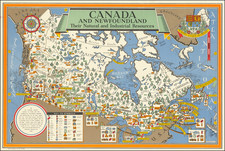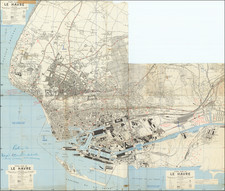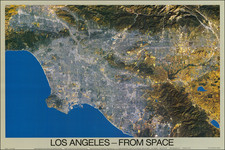African American WWII Servicemen Photo Diorama
By Muscogee Creek Native American Artist Ducee Blue Buzzard
"Collins Life Pictures" of Muskogee, Oklahoma
An amazing survival of a unique vernacular photographic object memorializing four African American WWII servicemen. This photographic diorama was made during World War II in Muskogee, Oklahoma, and likely depicts service members based at nearby Camp Gruber, which opened on May 12, 1942.
Based on careful research we can attribute this work to the noted Muscogee Creek artist, Howard Rufus Collins, who styled himself Ducee Blue Buzzard.
Though similar to Mexican fotoesculturas - those sculpted wood photo objects popular in mid-20th-century Mexico - the present diorama follows its own style format. Rather than a fotoescultura, the Collins Life Picture has more in common with the surrealist shadow boxes by Joseph Cornell. Indeed, at the time of the present piece, Cornell was still developing his assemblage art aesthetic, thus making the Collins Life Picture an interesting contemporary work to juxtapose to that of the renowned surrealist of Utopia Parkway.
The present diorama contains four hand-cut, lightly hand-tinted photographic portraits mounted on cardboard and attached on a base of red clay. A delightful color printed background provides a bucolic atmosphere. Palm trees to the left and right made of cardboard and red clay, topped with dried plant foliage further exoticize the setting. The foreground is composed of a mixture of dried foliage, plastic foliage, and dried flowers in yellow and pink.
The four unidentified African American servicemen are, from left to right: a (likely) United States Army enlisted infantryman, a United States Navy enlisted sailor in work coveralls, an Army enlisted man, and a commissioned Army chaplain. These servicemen, almost certainly connected with nearby Camp Gruber, were clearly loved ones and/or good friends of the person who commissioned this artwork.
Collins Life Pictures of Muskogee, Oklahoma
The diorama was created by Collins Life Pictures, based in Muskogee, Oklahoma, an art business listed in the 1948 Muskogee directory under its own classification of "Photographic Reproduction." The ink stamp label on the verso of the box reads: Collins Life Pictures / Phone 592 / P. O. Box 294 / 1204 York St. Muskogee, Okla.
Based on census records and the above-mentioned directory we can comfortably attribute this photographic object to Howard Rufus Collins (1894-1972), a Muscogee Creek Native American man who is listed in the 1950 census as working as a commercial artist in Muskogee. There is no other person residing in Muskogee with the name of Collins listed in either the 1940 or 1950 census associated in any manner with art production or photography.
Howard Rufus Collins was born in Checotah, Oklahoma, studied at Eufaula and Wetumka (Oklahoma) Creek Mission and St Joseph College (Muskogee). At some point Howard Collins adopted the name of Ducee Blue Buzzard, a play on the name of his more famous cousin, the Native American artist Acee Blue Eagle (Alexander C. McIntosh). Working in graphic design, he associated with a well-known Muskogee saddle shop, Bully Good Saddle Store. In later years he reportedly worked in the old Ritz Movie theatre in Muskogee which has since been demolished. In 1950 a local newspaper reported that Ducee Blue Buzzard had emblazoned a massive teepee with a map of Oklahoma for a local Boy Scout jamboree.
Collins Life Pictures was a short-lived business, which Collins ran as a specialty photo studio in Muskogee. An entry for the business in the 1948 Muskogee telephone directory documents that the business survived the war, when Collins likely took advantage of a brisk business in WWII servicemen portraiture. But Collins instilled a twist of "life" into his photographic works by creating a unique three-dimensional artwork for each of his customers. It is likely that he depended on the significant and relatively prosperous local African American community in Muskogee at that time as customers for Life Picture artworks.
African Americans in Muskogee
In the early 1940s Muskogee and nearby Taft had a large African American community of approximately 15000 people. According to the 1941-1942 Muskogee Oklahoma Negro Directory, published by the Commercial Club:
Educationally and intellectually, it has been said that Muskogee Negroes enjoy a prestiege [sic] unequaled anywhere else in America. As one old timer recently remarked, there’s more Negro lawyers, doctors, realtors, etc. to the square foot in Muskogee than there is anywhere else in the world.
Mary Jane Warde has described Muskogee's wartime African American community:
In 1941-1942 the Muskogee, Oklahoma Negro City Directory published by the Commercial Club proudly announced that the Muskogee-Taft area served a black population of about 15,000.... By constituting a quarter of the city’s population, they could swing elections with their ballots and had the ability to use them, a marvel to recent black immigrants from southern states. The writer lauded the black schools and thirty-four black churches... Just as the directory appeared, the nation was thrown into World War II. Young men and women, black and white, went to war, leaving others to pick up the slack at home. Construction soon began on Camp Gruber not far to the southeast near Braggs, Oklahoma. It was to be a training facility for American troops and a prison camp for German prisoners of war, most from Field Marshal Erwin Rommel’s Afrika Korps. The camp opened on May 12, 1942. The American troops stationed at the camp came to Muskogee, the closest large town, on leave, and residents made them welcome in businesses and homes. A WAC detachment stationed at Camp Gruber was made up of black female troops, while black soldiers are said to have used the building today known as the Martin Luther King Center at 627 North 3rd Street as a USO hall. The population of Muskogee, which had remained steady for years at about 40,000, surged to 50,000 with the wartime activity, in spite of a 1943 flood and a 1945 tornado. - Mary Jane Warde, Ph.D., The Historic Context for African American History in Muskogee, Oklahoma.
Art historian Geoffrey Batchen has written extensively on vernacular photographies, but makes no mention of Collins Life Pictures or Howard R. Collins. Nevertheless, his discussion of Mexican fotoesculturas, particularly their role in memorializing the people depicted, applies equally well to the present diorama:
...fotoesculturas were commissioned... for various reasons: to commemorate weddings...memorialize the dead, honor individuals... They were particularly popular during and after World War II, when many families were anxious to memorialize their absent sons. ...we find the photograph being treated as a tangible metaphor - as something one looks at rather than through, as an opaque icon whose significance rests on the ritual rather than visual truth. Where the photograph normally speaks to us of the past, the past in which the photograph was taken, a fotoescultura stolidly occupies the eternal horizon of the present. The photographs speaks of the catastrophe of time's passing, but the fotoescultura also speaks of eternal life; it posits the possibility of a perpetual stasis, the literal, fully dimensioned presence of the present - Each Wild Idea, pages 74-76.
A unique work of art which memorializes and honors the service of four African American men during World War II, while also serving as evidence of the links between an underappreciated Native American artist with the African American community within a western city during a pivotal time in American race relations.
Rarity
We have not been able to locate another example of a photo diorama by Collins Life Pictures.
Works by Ducee Blue Buzzard, mostly paintings, are held by numerous private collections and a few museums, notably the Charles Little Collection at Oklahoma State University.









![(Mississippi Bubble) Kermis Wind-Kraamer En Grossier [Fair of the wholesale wind-pedlar.]](https://storage.googleapis.com/raremaps/img/small/95945.jpg)
![[First California Wine Making Image] The Vintage In California -- At Work At The Wine Presses](https://storage.googleapis.com/raremaps/img/small/89054.jpg)


![Gerardus Mercator . . . [and] . . . Iudocus Hondius . . .](https://storage.googleapis.com/raremaps/img/small/78439.jpg)
